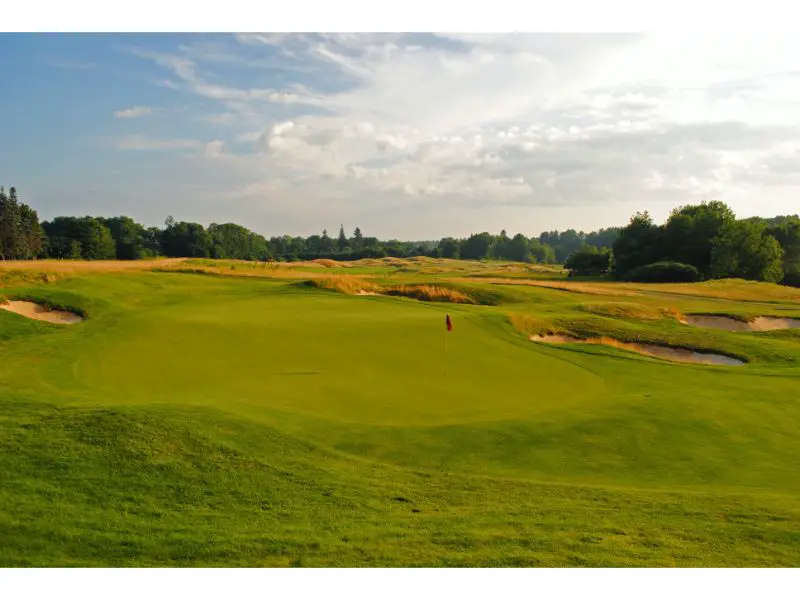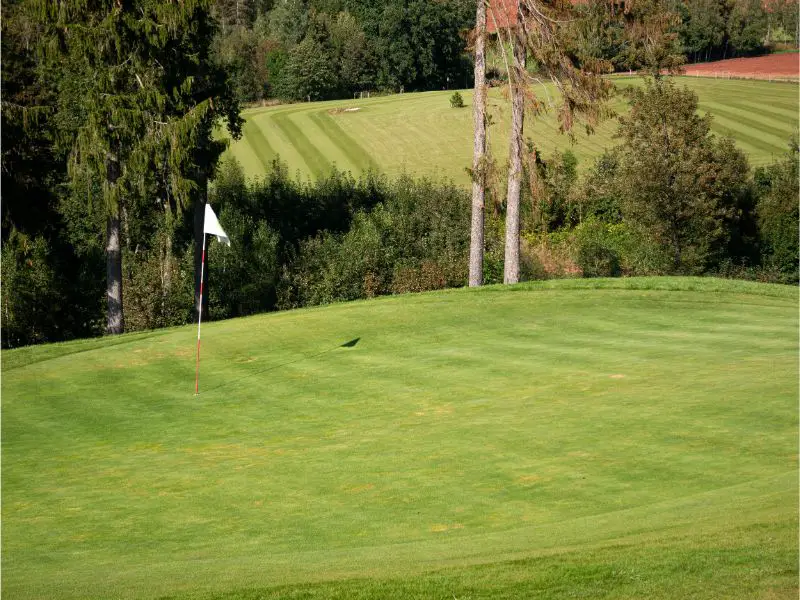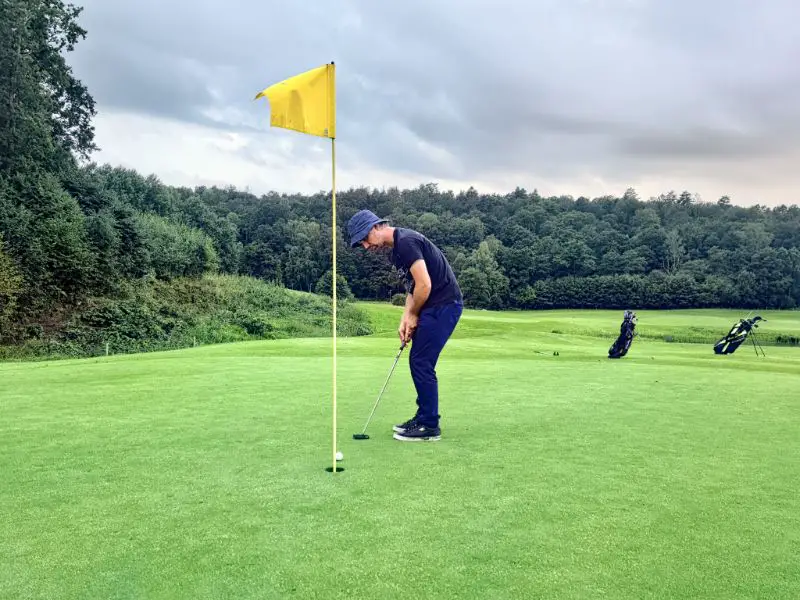Putting greens are the heart of a golf course’s design. The world’s best courses are defined by their challenging, picturesque greens.
The size and shape of a course’s greens can greatly affect the overall difficulty and playing experience of a golfer’s round.
Given the importance of the design of the greens on a course, one might wonder what factors determine the size and shape of a putting green.
In the article below, we will look at the standard size of putting green and how it varies across different courses. We will also outline what determines the size and shape of a putting green and the factors that make them difficult. We have a lot to cover so let’s get started!

What is a Standard Size Putting Green?
According to the United States Golf Association (USGA), a standard putting green should measure between 3,000 and 5,000 square feet. This size is optimal for golfers to practice their putting skills and provides enough space for rotating pin placement.
However, this size is not set in stone. Golf courses may have putting greens that exceed or fall below this range. Green size between holes can also fluctuate significantly.
Many factors come into play when determining the size of a putting green, such as the size and layout of the course, the available land, and the architect’s design choices. We will cover this in more detail below.
How Many Square Feet is an Average Green?
Putting greens are an essential component of a golf course. The size of putting greens can vary depending on the golf course’s size, design, and budget.
As mentioned earlier, the average size of a putting green ranges from 3,000 to 5,000 square feet. This size is considered optimal for most golf courses, as it provides enough space for a variety of putting angles and distances.
However, smaller golf courses may have putting greens that are less than 3,000 square feet. This is often the case for executive courses, which are smaller and designed for golfers who want to play a quicker round of golf. These courses may not have the space to accommodate larger putting greens, and a smaller putting surface can still provide a challenge for golfers.
On the other hand, larger courses may have greens that exceed 5,000 square feet. These courses may have more land to work with. This allows for larger putting greens that can accommodate more challenging hole locations. Additionally, larger putting greens can help spread out golfers during busy times and prevent congestion on the course.

What Is The Average Green Size On A PGA Golf Course?
A PGA Tour golf course’s typical green measures around 6,500 square feet in size. This can vary depending on the course design and the individual hole’s layout.
For example, some holes may have larger greens that require more strategic approach shots. Others may have smaller greens that demand more accuracy and precision with the golfer’s short game. Certain professional greens may also vary considerably in size from this average.
For example, Augusta National Golf Club, which hosts the Masters Tournament, is known for its large and undulating greens. Some of these greens can measure up to 9,000 square feet.
On the other hand, courses like Pinehurst No. 2, which has hosted several major championships, are known for their smaller greens that demand precise iron shots and a deft touch with the putter.
3 Factors That Determine The Size And Shape Of A Green
Putting greens are a key part of any golf course. Their size and shape can greatly affect the overall playing experience. But have you ever wondered what factors determine the size and shape of a green? In this section, we’ll explore three key factors that contribute to the size and shape of a golf green.

1.) Size and Layout of the Course
The length and size of a golf course is the primary determinant of a golf green’s size and shape. The size of the greens can vary according with the course size because larger courses may have bigger greens to facilitate longer putts.
The design of the course may also influence how the greens are shaped, as designers may want to create distinctive and difficult greens by utilizing the surrounding topography and scenery.
The size and form of the greens can also be impacted by the degree of difficulty of the course. Smaller and more complex greens on a harder course could call for greater ability and accuracy from the players.
In contrast, a more accommodating course can include bigger, clearer greens that let players concentrate on their putting strokes.

2.) Available Land
The available acreage is the next factor that influences the size and form of a golf green. Golf courses must work under the constraints of available land, which can have an impact on the size and shape of the greens.
If a course has limited room, the greens may be smaller and more compact. Conversely, if the course has plenty of land, the greens might be larger and more spread out.
The design of the greens can also be influenced by the amount of accessible area. Architects may have to work around impediments like trees, water hazards, or bunkers, which can result in distinctive and innovative green forms that add to the course’s challenge and beauty.
3.) Architect’s Design Choices
The third main factor that determines the size and shape of a golf green is the architect’s design choices. Golf course architects have the ability to create greens of any size and shape, depending on their vision for the course. Some architects may prefer more traditional round or oval greens, while others may opt for irregular shapes that follow the natural terrain.
Architects can also create greens with unique features such as tiers, ridges, or undulations, adding to the challenge and excitement of the course. The architect’s design choices can greatly impact the overall feel and difficulty level of the course and can make the difference between a mediocre course and a memorable one.
Factors That Make A Putting Green Difficult
Size
The size of a golf green influences its difficulty. A larger green means more space between the golfer and the hole, necessitating more skill to putt accurately.
Also, a larger green may have more undulations and slopes, making it more difficult to determine the pace and direction of the ball.
A smaller green, on the other hand, can be demanding in its own way. With less space to work with, golfers must be more precise with their shots to avoid striking the edges or overshooting the hole.

Length
Another important characteristic that influences the difficulty of a golf green is its length. Larger greens necessitate more accuracy and talent to putt due to the greater distance between the player and the hole. Before making a shot, golfers must consider the pace and slope of the green, as well as the distance.
Shorter greens may appear to be easier, but they can be just as difficult. Golfers must be precise in their aim to prevent overshooting the hole or hitting the edges with less distance to deal with.
Other Factors
Size and length are just two of the key factors that influence how challenging a golf green is. The speed and slope of the green, the location of the hole, and the topography nearby are further considerations. Even the most seasoned golfer may struggle on a green with a steep slope or a challenging pin placement.
Final Thoughts
The size and design of the putting green is a key element of every golf course. They can have a significant impact on the overall challenge and player experience.
The size of the course, the amount of available space, and the architect’s architectural preferences are all important considerations when selecting the size of a putting green, which is typically between 3,000 and 5,000 square feet.
The size and design of the golf course, the amount of land that is available, and the architect’s design decisions are three important elements that affect the size and form of a golf green.
The difficulty of a golf green is further influenced by the size, length, speed, slope, location of the course, and surrounding topography. In the end, a putting green’s layout and characteristics might differentiate between a mediocre
Hopefully, you liked this article and found it informative. Check out our other blog posts if you liked this one!


